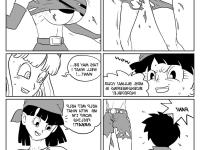Elamma comics









ABSTRACT While India is no stranger to titillating imagery, its pornographic circuits remain underground due to stringent laws. The emergence of Indian pornographic comics under the aegis of the adult entertainment company Indian Porn Empire has destabilized this framework through their dispersed production practices and viral circulation. This article examines two of the most popular comic book titles, Savita Bhabhi and Velamma, that feature married women as their protagonists. While interrogating these comics in terms of their content and effects, we suggest that the affordances of the comic book medium allow them to display a wider range of fantasies than both the amateur and soft porn that circulates in India. Thus, these comic books become sticky objects that absorb and express the dynamics of class, gender and taboo. The adult comic book visualizes sexual and moral anxieties on the two-dimensional plane of the comic book panel and becomes a canvas of fantasies that allows for vicarious boundary-crossing.
ARTICLE HISTORY Received 1 February 2018 Accepted 28 February 2019 KEYWORDS Adult comics;Savita Bhabhi; Velamma; India; fantasy
the ground for this trans-spatial circulation, because the drawn form, as opposed to live action, allows the sexual fantasy to come to the fore in a sustained fashion without the risks of a performer’s sole attachment to the character. This is a significant aspect in a country like India, where the production and circulation of pornography is illegal. As two-dimensional representations of sexual encounters, the comic book medium becomes a canvas of fantasies on which desires and explorations are played out. 2 Thus,figures such as Savita Bhabhi and Velamma are a graphic spatialization of sexual fantasies and taboo. Bothfigures are represented as married women and domestic space becomes essential to the imagination of transgression and sexual exploration. The panels in the comic book become the spaces of the domestic interior where the narrative unfolds. If domestic space is the space of the sexual encounter in these comics, then the comic book panels allow for the visual manifestation of the sexual imaginary. Here, the comic book form supplements the sexual imaginary –it is an extension of the imagined spaces of the domestic everyday–one that can potentially exist in real space, but under constant threat of closure by way of social norms and legal censorship. Thus, the comic book presents itself as a virtual appendage for the libidinal possibilities of real dom- estic interiors. The domestic becomes both a metaphor as well as an important represen- tational element in these comics. The homepages for both of the characters, Kirtu (Savita Bhabhi) and Velamma (Velamma), feature banners with the central characters in different stages of undressing, while declaring‘Welcome to my home’as an invitation to visitors. The status ofSavita BhabhiandVelammaas digital comics spatializes this imagin- ation of domestic space within the fast-moving sphere of internet circulation. Just as dom- esticity is destabilized on a representational level within the transgressive narratives of the comics, the digital renders the domestic doubly unstable by spatializing it within the non- space of the internet. 3 Thus, whileSavita BhabhiandVelammaare representations of carnal fantasies, they are marked by non-material erotics–i. the erotic charge of two- dimensional, non-fleshy bodies as well as an immaterial domesticity within the internet. This is not to say that it is the internet itself which is non-material, as computer networks, of course, constitute computer hardware andfibre-optic cables. When we invoke the non- material erotics ofSavita BhabhiandVelamma, we speak essentially of a fantasy space that is composed of libidinal energies and desires that are enabled by cybernetic virtuality. This fantasy space, again, is not the sole domain of the internet. For sure, such fantasy spaces (and the spaces where they are peddled) have existed without the medium of the internet. In the context of India, Sanjay Srivastava ( 2013 , 231), for example, talks of‘foot- path pornography’–cheap, poorly-bound Hindi print materials that are sold in transient spaces and offer the urban poor fantasies of transgressive desires, seductive‘Western women’and extramarital affairs. Srivastava positsSavita Bhabhias a part of‘“middle- class”sexual cultures’( 2013 , 228), something opposed to footpath pornography. While Srivastava’s analysis is largely useful for understanding the transient spaces of Indian pornography, its delineation as the domain of the urban poor is more ambiguous. As Rini Barman ( 2015 ) writes,‘we cannot categorise the consumers of these pulp porn maga- zines into one. The fact that they come in cheap, pulp paper with very low costs, doesn’t really say anything about the class of the consumers.’As fantasy spaces, the storylines and narrative drives of‘urban poor’and‘middle class sexual cultures’can often overlap. There is no clear outside or inside when it comes to readership, and the footpath aesthetic is something that is common to both middle-class and lower-class consumption. The
surreptitious pleasure that is associated with the consumption of erotic material is also marked by India’s obscenity laws that disallow the production and circulation of sexually explicit material. It is part of the logic of occlusion or partial visibility that lends porno- graphic cultures their‘footpath’or‘underground’nature. Laws against pornography trans- late moral anxieties into legal dictums that further marginalize sexual cultures in the region of the footpath. In this context, the platform of the internet and digital adult comics complicate the stringent framework of legality. 4 What we see in comic books such asSavita BhabhiandVelamma, then, is an appropria- tion of the footpath aesthetic that is transposed onto the mobile space of the internet. Savita Bhabhiand Velamma transform footpath pornography into internet chic. To borrow a term from Steven Marcus’work on Victorian pornography, this constitutes a kind of a pornotopia–‘the imagination of the entire universe beneath the sign of sexuality’ ( 2017 , 242). According to Marcus, pornotopias’‘true existence is not in the world […] They truly exist behind our eyes, within our heads’( 2017 , 268). In Marcus’conception, pornoto- pia erases clock-time in favour of the time of the erotic encounter. In some senses, then, pornotopia is always a virtual space. The fantasy spaces ofSavita BhabhiandVelammaare pornotopic to the extent that they insert the work of the libidinal imagination into the par- allel space of the network. If, as Wendy Chun ( 2006 , 83) reminds us,‘online pornography can be pervasive without being extensive’–that is, if they can reach vast audiences without necessarily being massive in scale–then online porn’s non-material erotics can have actual social impact. What comes across both in the content of these adult toons and in their reception is the playing out of surreptitious pleasures of watching contraband material, or what Shohini Ghosh ( 2017 ) calls the‘dissident pleasures of pornography’. 5 Ghosh describes pornography as a‘phantasmatic arena [that] does not reflect people’s “real”sex lives so much as it articulates the desires and aspirations for imagined ones’. In doing so, she placesSavita Bhabhias an extension of the sensuous bodies of women presented in mythological and historical comics such asAmar Chitra Katha, but without any of their monogamous, pious and heroic trappings. 6 Our examination ofSavita BhabhiandVelammaoscillates between these various spaces– the representational space of the narratives, the formal space of the comic book, the spaces of circulation over the internet and the social spaces where debates over legality and morality are played out. In this we follow Susanna Paasonen’s assertion that any investigation of pornogra- phy must account for‘how the images have been put together, what kinds of representational conventions have been used, and how these may have evolved and traveled from one medium to another’( 2011 , 258). In what follows, we examineSavita BhabhiandVelamma both in terms of form and content to demonstrate how their images and texts speak to us, how they resonate and through what channels they travel and accumulate meaning. ‘Meaning’,asPaasonen( 2011 , 256) reminds us,‘is not a property of pornographic images, texts, or videos but is something that is made possible through specificmaterialpractices’.
kind of a pan-Indian amalgamation of sexual fantasies related to boundary-crossing and clandestine pleasure. Regional markers become‘some place’in northern or southern India and are easily transposed to local contexts through textual translation. When trans- lated into regional languages,Savita BhabhiandVelammabecome bearers of cultural ver- isimilitude. Thus, the comic book characters become malleable surfaces onto which specific fantasies can be projected. We suggest that the form of the comic book and this linguistic/regional malleability go hand in hand. We draw on Scott McCloud’s( 1993 , 20) definition of comics as‘juxtaposed pictorial and other images in deliberate sequence, intended to convey information and/or to produce an aesthetic response in the viewer’. Language in comic books appears as textual and graphic elements, but never in its auditory aspect. So, the‘spoken’nature of the language of comic book speech remains tethered to the imagination and subjectivity of the reader. While this may appear to be a constraint, it makes the comic book format much more open to translation. Unlike a dubbedfilm where the gap between the move- ment of the mouth and the uttered sound are not in sync, making the audiovisual experi- ence awkward, the lack of any sonic element in the comic book makes the transposition of the fantasy element much smoother. In the comic book format, language is textual or graphic and the spoken sound of language is always a matter of the reader’s imagination. Thus, the cultural translation ofSavita BhabhiandVelammais a matter of replacing Hindi or English text in thought and speech bubbles with the script of another language. The fact thatSavita BhabhiandVelammafeature drawn rather than‘live’actionfigures is central to the malleability of their fantasy space. Unlike live-actionfigures, the drawn figure is only limited by the imagination of the author or the illustrator. The Kirtu website recommends Scott McCloud’s( 1993 )Understanding Comicsto potential writers who may have story ideas but not be conversant in the language of comics, pointing out that the fantasies that are scripted have to adhere to a certain form and aesthetic style. 12 In an interview with theErotic Review, Deshmukh states:
The comic book format allows for fantasy projection inSavita BhabhiandVelammain two ways. First, by rendering the object of desire as a two-dimensional surface, these comics remove references to‘real’bodies offlesh and blood. An argument could be made that printed pornographic images or moving images are also accessed as two-dimensional images; but in the case of live-action porn, the bodies on the screen always have a three-dimensional referent in the physical world. On the other hand, comic book charac- ters such as Savita and Velamma only exist as two-dimensional surfaces. Whenever real-life associations can be drawn, this works through cultural referentiality and intertextual knowledge, instead of an indexical relationship between the drawn body and the real world. For instance,Savita BhabhiEpisode 10,‘Banungi Mai Miss India’[‘I Will Be Miss India’], features a‘famous yesteryear’sfilm star’named Jeet Kumar, which is a thinly- veiled visual reference to Bollywood superstar Amitabh Bachchan. In this case, the simi- larity of the character to Bachchan’s character in the HindifilmKabhi Alvida Na Kehna ( 2006 ) ruffled some feathers, such as, for instance, when the director Karan Johar
transform into the‘hero of your favorite movie’through the endless possibilities offered by teleportation is premised on taking the place of someone who is already narratively placed in the diegetic space. 21 The dialogues in thefilm reiterate the‘Bhabhi’image, with Savita referring to herself in the third person as‘Bhabhi’. The temporal logic of teleportation in thefilm is echoed by Shor Bazaar’s song where the lyrics run‘in such dire circumstances […] its best to go online’. 22 While the song was certainly inspired by the comic book char- acter, it was not commissioned by the creators. Nevertheless, the song ended up in the opening credits of theSavita Bhabhianimatedfilm, marking the entirefilm as a kind of a meta-text about sexual freedom and resistance against censorship. Interestingly, the logic of identification used in thefilm–of transforming into the‘hero of your favorite movie’–also cropped up in relation to the censorship issue. For instance, with the initial ban onSavita Bhabhi, one of the allegations was that comics are‘a more participative medium [where a reader] imagines himself as the character’and, as one critic of the comic book suggested, this kind of participatory reading would even allow a young child to‘see a Savitabhabhi among his relatives’(Sruthijith 2009 ). Elsewhere, Deshmukh ( 2011 ) has responded to this line of criticism by writing:‘To say that Savita Bhabhi would inspire married women to become promiscuous is like saying Batman would inspire rich men to become nocturnal, cape-wearing vigilantes.’Thus, the debate over the censorship ofSavita Bhabhiwas also a debate about the medium of the comic book and its possibilities as a‘phantasmatic arena’(Ghosh 2017 ). As we pointed out earlier, the phantasmatic arena is slightly different in the case of the two comics. While both of them share similar comic styles, there is a stark difference in the fantasies of the female body associated with them. In the next section, we explore how the body politics ofVelammadiffer from those ofSavita Bhabhiand what these different imaginations allow the comics to do.
person. Following Susanna Paasonen ( 2011 , 16), we suggest thatSavita Bhabhiand Velammaare manifestations of a carnal resonance in the imagination of Indian online por- nography. Paasonen ( 2011 , 17) defines carnal resonance as both the affective power of pornography–‘its visceral appeal and power to disturb’–as well as the‘connections and movement between porn and its audiences that are always imprinted and marked by contexts and technologies of production, distribution, and circulation’. Comics such asSavita BhabhiandVelammaare essentially translations. They translate sexual imagin- ations, taboos and desires into consumable texts that can be distributed and exchanged. At the same time, they themselves remain translatable both in terms of their own vari- ations as well as derivations. Take, for instance, the issue of sonic presence inSavita Bhabhi’s intra-textual world, or the Savita Bhabhi‘universe’that is shared by the various comic book episodes, crossover issues and thefilm. TheSavita Bhabhicomics do not have any sound elements, but there are voice-actors in the animatedfilm. The website for theSavita Bhabhimovie features a‘Characters’section in which the characters in thefilm are introduced textually, visually and sonically. 24 The section features a thumbnail image, a blurb and a brief sound clip from the movie that attaches a voice to thefigure. The change of medium necessitates a sonic voice that replaces the way that readers might imagine the voice in the comic book. If the intra-textual is one arena of translation, another can be seen in derivative forms that borrow from theSavita BhabhiandVelammaimaginaries. On porn-aggregator web- sites such as Xvideos, Xhamster, Xnxx and PornHub, the search terms‘Savita Bhabhi’and ‘Velamma’lead to sequential videos of the comic book pages and live-action porn. In most cases, these are amateur videos that are tagged with the keywords‘Savita Bhabhi’and ‘Velamma’, inserting the comic book imaginary into an existing economy of sexual
fetishes. However, there are also stand-alone websites that cater to specifically live-action versions of the Savita Bhabhi and Velamma fetishes. For instance, the website Velammab- habhi features a masked, live-action porn performer who plays the role of Velamma. This‘live’Velamma is described on the homepage of the website as‘a big tits south Indian MILF […] with a plump body’, playing into the‘flab andflesh’imaginary that Mukhopad- hyay describes. 25 On another website, MySexySavita, a similar representational strategy is used to present another masked porn performer. Unlike the earlier website where the association with theVelammacomics is through the name only, MySexySavita goes on to declare that it is the‘home of Savita Bhabhi Indian cartoon character [that] turns into reality’and videos within the website also feature her‘husband’Ashok. 26 The videos on the two websites are typical of low-budget porn and have almost no relationship to the VelammaorSavita Bhabhistories, but draw directly from the popularity of the series. Both are pay-sites (although their contentfloats around on porn aggregator sites) and are owned and operated by the Cyprus-based company Yellowplum that describes itself as a‘global leader in adult entertainment, consulting, technology and billing sol- utions’. 27 No other information about the two websites is available, but the nomenclature of the‘bhabhi’figure and the use of the names‘Velamma’and‘Savita Bhabhi’displays a translation of the two-dimensional comic book imaginary into a live-action form that becomes monetized in the exchange economy of the web. Here, the‘carnal resonance’ of Savita Bhabhi and Velamma is both a factor of what imaginaries the comic books play with as well as the fantasies and systems of exchange and circulation that they foster. The immaterial bodies of Savita and Velamma are given shape and form by actual human bodies that reflect their potentialities. In this sense,Savita BhabhiandVelammaare sticky objects–they are texts that absorb the peaks and falls of sexual cultures in India and, at the same time, new formulations and articulations of sexual expression also attach themselves to them. Boundary-crossing in these comics, to use a pun, is an orgiastic assemblage of the pulse of contemporary Indian society. As Eva Illouz writes,‘Literature–good or bad–puts into form what is often at the level of inarticulate social experience’( 2014 , 21). IfSavita Bhabhi and Velammaresonate with contemporary readers of sexualfiction, it is only because the depictions of hardcore sex and transgression in these comics are expressions of anxieties about new arrangements of family, class and tradition. To take a cue from Illouz ( 2014 , 23), Savita BhabhiandVelammaresonate with their readers because they articulate‘a social experience that is baffling, that presents itself as a repeated cognitive and emotional chal- lenge’. If morality and law respond to changing social arrangements by delimiting the sexual within the realm of the obscene and the illegal,Savita BhabhiandVelamma explore these arrangements by stretching them to their most extreme libidinal limits.




















